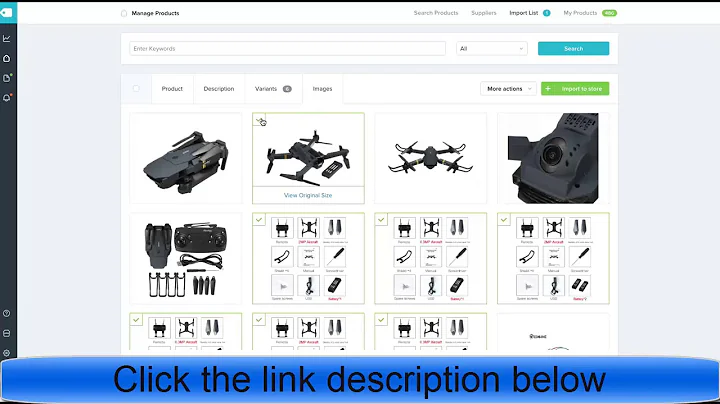Start a Profitable Clothing Line with Drop Shipping
Table of Contents
- Introduction to Drop Shipping
- How Drop Shipping Works
- Types of Drop Shipping
- 3.1 Manufacturing-On-Demand Drop Shipping
- 3.2 Inventory-Based Drop Shipping
- Pros and Cons of Drop Shipping
- Setting Up a Drop Shipping Business
- 5.1 Choosing a Niche
- 5.2 Finding Suppliers
- 5.3 Building an Online Store
- 5.4 Marketing and Driving Traffic
- 5.5 Managing Orders and Customer Service
- Drop Shipping Tools and Platforms
- 6.1 Shopify
- 6.2 WooCommerce
- 6.3 Oberlo
- 6.4 SaleHoo
- 6.5 Printful
- Tips for Success in Drop Shipping
- 7.1 Research and Analysis
- 7.2 Competitive Pricing
- 7.3 Quality Control
- 7.4 Customer Satisfaction
- 7.5 Continuous Learning and Adaptation
- Common Challenges in Drop Shipping
- 8.1 Supplier Issues
- 8.2 Inventory Management
- 8.3 Shipping and Delivery
- 8.4 Returns and Refunds
- 8.5 Customer Complaints
- Drop Shipping vs Traditional Retail
- Conclusion
Article
Introduction to Drop Shipping
Welcome to the world of drop shipping – an innovative business model that allows you to start an e-commerce venture without the overhead costs and risks associated with traditional retail. In this article, we will explore everything you need to know about drop shipping, from how it works to the pros and cons, and provide practical tips for success in this competitive industry.
How Drop Shipping Works
Drop shipping is a simple yet powerful concept. Instead of holding inventory and shipping products yourself, you partner with manufacturers or wholesalers who handle the production and fulfillment process on your behalf. When a customer places an order on your online store, you forward the order details to your drop shipping partner, who then packages and ships the product directly to the customer. You earn a profit by charging a markup on the product price.
Types of Drop Shipping
There are two main types of drop shipping: manufacturing-on-demand and inventory-based drop shipping.
Manufacturing-On-Demand Drop Shipping
With manufacturing-on-demand drop shipping, you don't need to invest in inventory. Instead, your drop shipping partner manufactures the product only after receiving an order from your customer. This approach is cost-effective and allows for greater flexibility in terms of product variety and customization. However, it may result in longer fulfillment times and lower profit margins compared to inventory-based drop shipping.
Inventory-Based Drop Shipping
In inventory-based drop shipping, you invest in purchasing and storing inventory upfront. This approach allows for faster fulfillment and potentially higher profit margins. You partner with a fulfillment center or drop shipper who holds and manages your inventory. When an order is placed, the drop shipper packages and ships the product, saving you time and effort. However, this method requires more upfront investment and carries the risk of unsold inventory.
Pros and Cons of Drop Shipping
Before diving into drop shipping, it's important to consider the advantages and disadvantages of this business model.
Pros
- Low upfront investment: Drop shipping eliminates the need to purchase and store inventory upfront, reducing your initial investment and financial risk.
- Easy scalability: As you don't need to worry about fulfillment and inventory management, scaling your business becomes easier and more efficient.
- Wide product selection: With drop shipping, you can offer a wide range of products without the burden of manufacturing or storing them yourself.
- Location independence: As long as you have an internet connection, you can run your drop shipping business from anywhere in the world.
- Reduced overhead costs: By outsourcing fulfillment and inventory management, you can save on warehousing costs, staff, and equipment.
Cons
- Lower profit margins: Due to the fees charged by drop shipping partners and the need to remain competitive in pricing, profit margins in drop shipping tend to be lower compared to traditional retail.
- Reliance on suppliers: Your success in drop shipping relies heavily on the reliability and efficiency of your drop shipping partners. Issues such as stock availability and shipping delays can directly impact customer satisfaction.
- Limited control over fulfillment: Since you hand off the fulfillment process to your drop shipping partner, you have less control over packaging, shipping speed, and quality assurance.
- Intense competition: Drop shipping has gained popularity, leading to increased competition. Differentiating your store and products can be challenging in a saturated market.
- Customer service complexity: As the middleman between the customer and the drop shipper, you are responsible for handling customer inquiries, returns, and refunds.
Setting Up a Drop Shipping Business
To get started with drop shipping, follow these steps:
1. Choosing a Niche
Select a specific niche or industry for your drop shipping business. Specializing in a particular area allows you to target a specific audience and establish yourself as an authority.
2. Finding Suppliers
Research and identify reliable suppliers who offer drop shipping services. Look for suppliers with a strong track record, competitive pricing, quality products, and good customer service.
3. Building an Online Store
Create an online store using an e-commerce platform like Shopify, WooCommerce, or BigCommerce. Customize your store design, add product descriptions and images, and optimize it for search engines.
4. Marketing and Driving Traffic
Implement various marketing strategies to drive traffic to your online store. Utilize social media, content marketing, search engine optimization, and paid advertising to reach your target audience.
5. Managing Orders and Customer Service
Implement efficient order management systems and processes to handle incoming orders from customers. Provide excellent customer service to ensure a positive shopping experience and encourage repeat business.
Drop Shipping Tools and Platforms
To streamline your drop shipping operations, you can leverage various tools and platforms designed specifically for this business model. Here are some popular options:
1. Shopify
Shopify is a leading e-commerce platform that offers built-in drop shipping features, including integrations with drop shipping apps and suppliers. It provides a user-friendly interface, customizable themes, and robust inventory management capabilities.
2. WooCommerce
WooCommerce is a WordPress plugin that enables you to turn your website into an online store. It offers extensions and plugins for drop shipping functionality, making it easy to integrate with suppliers and automate order fulfillment.
3. Oberlo
Oberlo is a Shopify app that allows you to import products from various suppliers into your online store. It automates the fulfillment process, allowing you to focus on marketing and growing your business.
4. SaleHoo
SaleHoo is a platform that connects drop shippers with reliable suppliers. It provides a directory of verified suppliers, market research tools, and educational resources to help you succeed in drop shipping.
5. Printful
Printful is a print-on-demand drop shipping service that specializes in custom apparel and merchandise. It integrates seamlessly with various e-commerce platforms, allowing you to create and sell your own branded products.
Tips for Success in Drop Shipping
To thrive in the competitive drop shipping industry, consider the following tips:
1. Research and Analysis
Conduct thorough market research to identify profitable niches and trending products. Analyze competitor strategies, customer preferences, and market demand to make informed business decisions.
2. Competitive Pricing
Determine competitive yet profitable pricing strategies for your products. Consider factors such as product cost, shipping fees, and market demand. Regularly review and adjust your prices to stay competitive.
3. Quality Control
Choose reputable suppliers and maintain regular communication with them to ensure product quality. Conduct quality control checks to verify the consistency and reliability of your suppliers' products.
4. Customer Satisfaction
Prioritize excellent customer service to build trust and loyalty. Respond promptly to inquiries, handle returns and refunds efficiently, and strive to exceed customer expectations.
5. Continuous Learning and Adaptation
Stay updated with the latest industry trends, marketing techniques, and technological advancements. Continuously learn and adapt your strategies to stay ahead of the competition and meet evolving customer demands.
Common Challenges in Drop Shipping
While drop shipping offers many benefits, it also comes with its fair share of challenges. Here are some common ones:
1. Supplier Issues
Reliance on suppliers makes you vulnerable to potential issues such as stock shortages, product quality inconsistencies, or supplier pricing changes. Maintain open communication with your suppliers to minimize these risks.
2. Inventory Management
If you opt for inventory-based drop shipping, managing your inventory levels becomes crucial. Balancing supply and demand, avoiding overstocking or understocking, and monitoring product performance are essential for success.
3. Shipping and Delivery
Shipping delays or errors can lead to customer dissatisfaction and negative reviews. Work closely with your drop shipping partners to ensure efficient shipping and reliable delivery services.
4. Returns and Refunds
Handle returns and refunds promptly and professionally. Have a well-defined return policy in place, and communicate it clearly to your customers. Streamline the process to minimize customer frustration.
5. Customer Complaints
Address customer complaints promptly and proactively resolve issues. Actively seek feedback to identify areas for improvement and take necessary measures to enhance the overall customer experience.
Drop Shipping vs Traditional Retail
Drop shipping and traditional retail have distinct differences that are worth considering:
- Inventory: Drop shipping eliminates the need to hold inventory, while traditional retail requires upfront investment in purchasing and managing stock.
- Overhead Costs: Drop shipping reduces overhead costs associated with warehousing, staff, and physical store maintenance, whereas traditional retail incurs these expenses.
- Scalability: Drop shipping allows for easy scalability as you don't have to worry about storage or fulfillment logistics. Traditional retail may require physical expansion and increased staffing to grow.
- Profit Margins: Traditional retail generally offers higher profit margins per product sold, while drop shipping often has lower margins due to fees and competition.
- Control: Traditional retail provides more control over the entire supply chain, from product selection to branding and customer experience. Drop shipping hands off many aspects of fulfillment and customer service to the drop shipper.
Conclusion
Drop shipping offers entrepreneurs an exciting opportunity to start an e-commerce business with minimal upfront investment and risks. By understanding the intricacies of drop shipping, leveraging the right tools and platforms, and implementing effective strategies, you can build a successful and profitable online store. Remember to stay adaptable, continuously learn, and prioritize customer satisfaction to thrive in this ever-evolving industry.
Highlights
- Drop shipping is a low-risk business model that allows you to partner with manufacturers or wholesalers to fulfill orders on your behalf.
- There are two main types of drop shipping: manufacturing-on-demand and inventory-based drop shipping.
- Pros of drop shipping include low upfront investment, easy scalability, wide product selection, location independence, and reduced overhead costs.
- Cons of drop shipping include lower profit margins, reliance on suppliers, limited control over fulfillment, intense competition, and customer service complexity.
- Key steps in setting up a drop shipping business include choosing a niche, finding reliable suppliers, building an online store, marketing, and managing orders and customer service.
- Popular drop shipping tools and platforms include Shopify, WooCommerce, Oberlo, SaleHoo, and Printful.
- Tips for success in drop shipping include thorough research and analysis, competitive pricing, quality control, customer satisfaction, and continuous learning.
- Common challenges in drop shipping include supplier issues, inventory management, shipping and delivery, returns and refunds, and customer complaints.
- Drop shipping differs from traditional retail in terms of inventory, overhead costs, scalability, profit margins, and control over the supply chain.
FAQ
Q: Is drop shipping a profitable business model?
A: Drop shipping can be profitable, but it depends on various factors such as product selection, pricing strategies, competition, and supplier reliability. It requires careful planning, research, and effective execution to achieve profitability.
Q: How do I find reliable suppliers for drop shipping?
A: Finding reliable suppliers is crucial for the success of your drop shipping business. You can conduct online research, attend trade shows, explore wholesale directories, and reach out to manufacturers directly to identify trustworthy suppliers.
Q: Are there any upfront costs associated with drop shipping?
A: While drop shipping eliminates the need for large upfront investments in inventory, there are still costs to consider. These include website and hosting fees, marketing expenses, drop shipping platform costs (if applicable), and potential fees charged by suppliers.
Q: What happens if a customer wants to return a product?
A: As the retailer, it's your responsibility to handle customer returns and refunds. Establish a clear return policy and process, communicate it to your customers, and work closely with your suppliers to facilitate smooth returns and refunds.
Q: Can I build a brand with drop shipping?
A: Yes, it is possible to build a brand with drop shipping. Focus on providing a unique customer experience, offering quality products, and developing a strong brand identity through your website, packaging, and customer service.
Q: How can I differentiate my drop shipping store in a saturated market?
A: To stand out in a saturated market, consider specializing in a specific niche, offering unique products or customization options, providing exceptional customer service, and implementing effective marketing strategies to target your ideal customers.



















